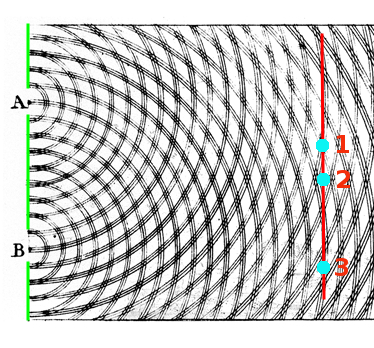Interference


Now the green wall, mentioned in the diffraction page, is modified as shown in the picture to the right. It contains two openings, call them A and B, in stead of one.
Now the waves coming through both openings will diffract and start expanding circularly. The wavefronts all move at the same speed.
Again a detector is placed behind the wall: the red line.
Observe that the distances from A to points 1, 2 and 3 on the detector and from B to the same points, are all different.
This causes the wavefronts from A and B to arrive at different times at the locations 1, 2 and 3 on the detector (same speed, different distance) resulting in differing amplitudes at the time of arrival.
The observed pattern on the detector is again an alternating light-dark pattern! It looks very much like the diffraction pattern, which is not surprising, since the underlying physics is the same, only it's called an interference pattern.
If two waves arrive at the same point in space the amplitudes add up to form the brightness at that point. Three regimes can be discriminated:
- Both waves have the maximum amplitude: they amplify each other maximally and at that spot it will be doubly bright (point 1 in the image).
- The waves have exactly opposite amplitudes: one is at maximum and one at minimum. The amplitudes add up to nothing, or total darkness for short (point 2 in the image).
- Anything inbetween this will lead to gray patches, the intensity of which depending on the exact sum of the amplitudes (point 3 in the image).
